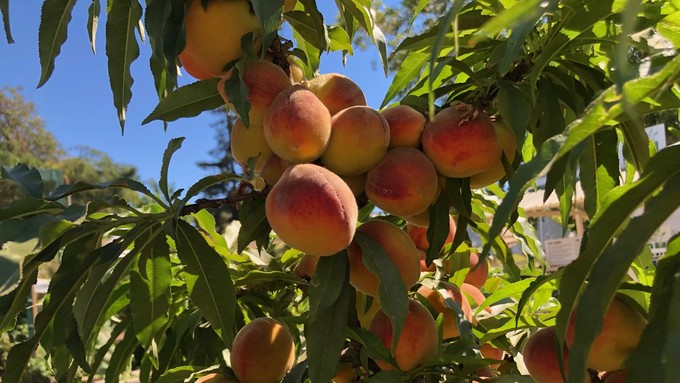
Overloaded branches can break under the weight

How not to grow peaches: This tree at Cal Expo last July should have thinned months earlier. The guide: A hand's width between fruit. Kathy Morrison
The pride of fruit tree gardeners in their crop is something to see. After all, they've battled gusty winds, late frosts, a lack of pollinators, weather-borne diseases -- and that's before the fruit ripens, when the birds and squirrels come after it. On top of this, why would they want to thin that crop they're so proud of?
Because an overloaded fruit tree is a stressed tree, and it might break under all that weight.
Last summer, the Sacramento County master gardeners who worked at the State Fair could not get over the predicament of the little peach tree that was just a few feet from their booth. It had never been thinned that year, and was jammed with ripening fruit. It looked uncomfortable at the very least. Fruit that touches while growing like that also makes it easier for diseases or pests to spread through the crop.
On a much bigger tree, that crop could bring down a branch or even split the tree. The full-size fruit trees in the back of The Farm area were just as jammed. (Also disease-ridden, but that's a post for another day.) Fortunately, there are few walkways back in that area, so fairgoers weren't in too much danger from falling branches.
Here's "The Home Orchard," the UCCE master gardeners' guide, spearheaded by the late Chuck Ingels, on the subject:
"A tree's leaves supply energy for growth; if there are not enough leaves to support the number of fruit that set, the fruit will, in effect, compete with each other for carbohydrates and so remain small. ... Although thinning reduces the number of fruit and total yield, it improves the size and quality of fruit."
Most stone fruits except cherries require thinning most years. Fruit can be thinned any time from just after bloom to a few weeks before harvest, "The Home Orchard" notes. The book suggests April to mid-May (ahem, now) as the best time to thin, when fruit are big enough to assess but not so big that you risk breaking branches.
Peaches or nectarines on a healthy tree growing under ideal weather conditions should be thinned to 5 to 7 inches apart (about a hand's width), the book notes. Apricots and hybrids such as apriums are smaller, so 3 to 5 inches apart is recommended, and 4 to 6 inches for plums and pluots. Get rid of one of the "doubles" that develop and retain the largest fruit. Toss rejects into the organic waste bin.
So buck up, fruit growers -- bravely thin those unripe peaches and plums now. Your tree will thank you later.
For more on orchard tree care, visit https://sacmg.ucanr.edu/Fruit_and_nuts/ on the Sacramento County master gardeners' website.
Comments
2 comments have been posted.Sacramento Digs Gardening to your inbox.
Sites We Like
Garden Checklist for week of May 12
Get your gardening chores and irrigation done early in the day before temperatures rise.
* Plant, plant, plant! It’s prime planting season in the Sacramento area. Time to set out those tomato transplants along with peppers and eggplants. Pinch off any flowers on new transplants to make them concentrate on establishing roots instead of setting premature fruit.
* Direct-seed melons, cucumbers, summer squash, corn, radishes, pumpkins and annual herbs such as basil.
* Harvest cabbage, lettuce, peas and green onions. This heat will cause leafy greens and onions to flower; pick them before they bolt.
* In the flower garden, direct-seed sunflowers, cosmos, salvia, zinnias, marigolds, celosia and asters.
* Plant dahlia tubers. Other perennials to set out include verbena, coreopsis, coneflower and astilbe.
* Transplant petunias, marigolds and perennial flowers such as astilbe, columbine, coneflowers, coreopsis, dahlias, rudbeckia and verbena.
* Keep an eye out for slugs, snails, earwigs and aphids that want to dine on tender new growth.
* Feed summer bloomers with a balanced fertilizer.
* For continued bloom, cut off spent flowers on roses as well as other flowering plants.
* Got fruit trees? If you haven't already done so, thin orchard fruit such as apples, peaches, pears, pluots and plums before they grow too heavy, breaking branches or even splitting the tree. Leave the largest fruit on the branch, culling the smaller ones, and allow for 5 to 6 inches (or a hand's worth) between each fruit.
* Thin grape bunches, again leaving about 6 inches between them. For the remaining bunches, prune off the "tail" end, about the bottom third of the bunch, so that the plant's energy is concentrated in the fruit closest to the branch.
* As spring-flowering shrubs finish blooming, give them a little pruning to shape them, removing old and dead wood. Lightly trim azaleas, fuchsias and marguerites for bushier plants.
* Add mulch to the garden to help keep that precious water from evaporating. Mulch also cuts down on weeds. But don’t let it mound around the stems or trunks of trees or shrubs. Leave about a 6-inch to 1-foot circle to avoid crown rot or other problems.
Rather than toss those little green peaches, make them into refrigerator pickles. This is the first year I've attempted this and they are still 3 weeks from being ready to test, but I'm happy that there is a use for them other than as compost. The recipes I followed came from the Crafty Cookery website - one sweet, one savory. Note that these are not processed and thus must be stored in the refrigerator, so be sure you can dedicate the space to it before starting. There is not safe tested recipe for processed green peach pickles. At least not yet.
Cool idea! I've made other refrigerator pickles. Will have to check out that website.